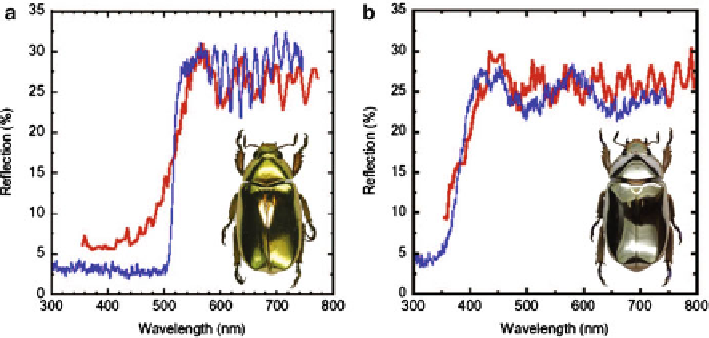Biomedical Engineering Reference
In-Depth Information
Fig. 8.17
Measured (
blue lines
) and calculated (
red lines
) reflection spectra for
C. aurigans
(
a
)and
C. limbata
(
b
). Calculated results are based on chirped multilayers with linearly decreasing
values in the thickness of the sequence of layers (Reproduced from [
81
])
A periodic multilayer can produce high reflections over a narrow wavelength range.
5
However, a chirped multilayer produces wide-band reflections. This is because for
different wavelengths constructive interference occurs for the layers with different
correct
thicknesses, which can result in silvery or golden coloration. For example,
certain scarabaeid and tortoise beetles, and lepidopteran larvae and pupae exhibit
silvery or golden hues which are caused by chirped multilayers [
77
].
In the pupaes of the butterflies
Amauris ochlea
and
Euplorea core
, most of their
cuticles display a strong metallic golden or silvery luster. Electron microscopic
observations revealed a chirped multilayer consisting of up to 250 pairs of bilayers
in the exocuticle [
78
,
79
]. The most striking example of metallic golden or silvery
coloration may be given by the Coleoptera
Chrysina aurigans
and
Chrysina limbata
[
81
].
C. aurigans
displays a brilliant golden color, while
C. limbata
shows a brilliant
silvery color, as shown in Fig.
8.17
. Chirped multilayers with linearly decreasing
values in the thickness of the sequence of layers were assumed, which could result
in reflection spectra in good agreement with the measured ones. Metallic silvery
coloration is due to a chirped multilayer with constituent layers that can reflect all
visible wavelengths. However, in a chirped multilayer without suitable constituent
layers that can reflect blue and violet light, metallic golden coloration can be
achieved.
Conventional photonic media do not produce circular dichroism. In other words,
there is no distinction between left- and right-handed circular polarizations. In
contrast, there may exist strong circular dichroism in chiral media. It was shown
for the first time by Michelson in 1911 that some scarab beetles can differentially
5
In other words, the resulting structural color is bright and highly saturated.

